INTRODUCTION
In human beings, cognition involves a variety of mental processes such as perception, attention, memory, reading and thinking that are highly interrelated to each other. One of the most fundamental cognitive processes is reading, which is commonly associated with the storage and perception of the presented visual information. The intriguing aspect of psycholinguistic research is the implemented techniques to enhance reading performance and perception of visual information. Thus, the question arises if colour luminance could possibly result in improved reading performance or psychological pleasure? Reading comprehension involves language-specific processes, as well as domain general cognitive abilities, wherein a variation in any of these abilities potentially, underlies individual differences in comprehensive abilities.1 A study by Jackson et al1 proved that fast readers demonstrate better performance in reading and tasks like verbal, quantitative reasoning, short-term auditory memory, and speech comprehension; matching task has long-term memory to capture more information from each reading fixation.2 Chen et al, in his study emphasized that text colour had a more pleasing effect to read than black colour text in a white background. Reading performance also proved to be better with coloured text letters than black and white combinations of visual display units and computer screens; variable spacing between the jump lengths of letters also play an important role in reading comprehension.3 Green et al validated that poor colour combinations for background displays did not attract the readers’ ability to read with pleasure and caused visual discomfort, especially with the warm colours.4 However, clinically, colour discrimination also varies under different luminance sources as was discussed in a study conducted by Ram et al who explained that colour discrimination with ishihara colour vision plates were influenced by tungsten illumination. White fluorescent light has been associated with a better colour discrimination and a pleasant feeling.5 Korbin et al in a study proved that visual cognition associated with computer-based tasks increases relative to printed material; however, the working memory and cognitive demand is the same in both groups but verbal protocol analysis impacted constructive behavioral process compared to paper and pencil test strategies.6 Geske et al illustrated in his study that effects of the process of reading on a computer screen at the textual level, and comprehension and information processing, involved decoding of visual information and flicker frequency on the screen which affected the processing of brain activity. However, it did not affect reading printed material.7 Allington et al reported that reading without a prior idea or theme on the subject disrupted attention in undertaking tasks.8
However, many vision science researchers explained the function and physiology of eyes during reading and the influence of technology on visual cognition.9 Many researchers have proposed variables in earlier studies that contribute to the retrieval operations in linguistics and reading.
One of the most important variables is colour and luminance, which will be discussed in the present paper and it will be attempted to elucidate how psychological pleasure is influenced by the colour luminance during reading.
MATERIAL AND METHODS
Participants
Sixty participants belonging to the age group between 19-21 years (male=29 and female=31) participated in the study as has been recorded in Table 1. All the participants were students of University of Hyderabad, Hyderabad, TS, India who were native english speakers and bilinguals with fluent in reading and writing english comprehension. The present study was undertaken by complying with the norms of the Declaration of Helsinki and Institutional Ethics Committee (IEC) approval from the School of Medical Sciences, University of Hyderabad, Hyderabad, TS, India, having received the verbal and written consents from the participants. No monetary award was given to the participants for participating in the study. All the participants were naive to the experiment.
| Table 1: Demographic Data of the Participants. |
| Gender |
Age (Mean±SD) |
N% |
Range (years) |
| Male |
19.76±1.13 |
29 (48%) |
19-21 |
| Female |
19.80±0.80 |
31 (52%) |
19-21 |
Visual Stimulus
English comprehension reading passage showed an equal readability score based on SMOG index formulae in the psycholinguistic readability text calculator.10 This passage used as a near visual stimulus consisted of fourteen lines of english sentences written in Times New Roman style of 12-point size with bold letters and these passages were printed against a non-glossy white background sheet in black, to avoid reflections. Visual stimulus content shows a different composition of words, but the readability score of every passage is and these passages were randomly presented to the participants to read under two different colour luminance sources. However, repeatability of passage has not been done. Every participant was presented with an equal readability score passage with different words. The reading was done loudly by the participants in the closed room. The size of reading stimulus chart was 21×29.7 cm (Figure 1).
Figure 1: Visual Stimulus Presented to the Participants as Reading Comphrension Passage
| A river begins at a source or more often several sources follow a path called a course and ends at a mouth or mouths. The water in a river is usually confined to a channel, made up of a stream bed between banks. In larger rivers, there is often also a wider flood plain shaped by floodwaters overtopping the channel. Floodplains may be very wide about the size of the river channel. This distinction between river channel and floodplain can be blurred, especially in urban areas where the floodplain of a river channel can become greatly. A river is a naturally flowing watercourse, usually fresh water flowing towards the side by ocean, sea, lake or another river. In some cases, a river flows into the ground and becomes dry at the end of its course without reaching another body of water. Small rivers can be referred to using names such as the stream, creek, brook, rivulet, and rill. There are no official definitions for the generic term river as applied to geographic features, although in some countries or communities a stream is defined by its size. Many names for small rivers are specific to geographic location few examples are “run” in some parts of the United States, “burn” in Scotland and northeast England, and “beck” in northern England. Sometimes a river is defined as being larger than a creek, but not always the language is vague. Rivers are part of the hydrological cycle. Water collects in a river from precipitation through a drainage basin from surface runoff and other sources such as groundwater. Rivers can be classified as either alluvial, bedrock, or some mix of the two. Alluvial rivers have channels and floodplains that are self-formed in unconsolidated or weakly consolidated as the importance of Rivers in India.
Readability Consensus
Based on Smog Readability Calculator, we have scored your text:
Grade Level: 12-13
Reader’s age: 15-17 years old (college level entry)
|
Experimental Apparatus
A digital Photometer-HS1010 was used for calculating the intensity of light. Two luminance sources—warm white colour (CFL-15 watt, 3000-Kelvin colour temperature) and warm orangish colour (Tungsten-100 watt, 3000-Kelvin temperature) was used. However, the intensity of 400-lux was constant from the two lighting sources. The luminous efficiency of these lighting sources measured the effectiveness of luminance and composition of warm light with constant 400 lux intensity for specific reading tasks. The standards were followed according to the International Commission on Illumination (CIE) to provide a psychophysical analog of radiance. Kadio KD-2004 stopwatch was used to record the reading time and reading pad of 5×5 feet was adjusted to hold the reading material.
Experimental Procedure
The experiment began with the instructions regarding what the participants needed to do, participants were seated under overhead illumination of 1-meter from lighting source to reading pad and the viewing distance from the participant’s eye to visual stimulus was 40 cm (self paced reading task). After deciding on the seating arrangement, a reading passage with the above visual stimulus presented to read fewer than two colour luminance sources (white and warm orangish). The reading task was loud and audible to the experimenter in the closed room. However, the repeatability of the passage for the other participants was avoided and also the reading by the participants was checked by the experimenter to note down the errors and also record the corresponding reading time using a stop watch. After the completion of this reading task, all the participants were given a psychological questionnaire to give their feedback on the pleasure of reading under two colour luminance sources.
Data Acquisition and Analysis
The collected experimental data was maintained in a Microsoft excel sheet version-2007. All the variables used for evaluating the reading performance in the manuscript was analyzed using a Graphad prism-7 version statistical software. Before running the analysis, data was checked for normality distribution with the Shapior-Wilk test followed by a Chi-square test and after measuring the Pearson correlation between the two groups for the reading variables. However, the psychological questionnaire was validated using the Cronbach’s alpha test and Matlab version-2015A and Grapher version-12 was also used as a computational software for the plotting the reading time peaks and the other graphs in the manuscript.
RESULTS
All the dependant variables were analyzed and it was noted that an evident trend in the significant result was observed when the reading rate and the reading speed was compared among white and orange colour luminance [p<0.001, X2=53.20] as has been reported in Table 2, Figures 2 and 3. Reading errors were also compared and it was found that significant difference [p<0.001, X2=23.58] existed between white and orange colour luminance with positive correlation (r=+0.778) as is evident in Table 3, Figure 4. However, Reading symptoms were maximum in orange (86%) followed by (46%) white luminance with significant trend [p<0.001, X2=52.23] and psychological pleasure among both the groups for White luminance (80%) and (20%) as has been reported in Figure 7. The reading times peak represented a high in warm orangish colour 210 sec and low in white colour luminance 171 sec as can be observed in Figures 5 and 6.
| Table 2: Chi-square Test Showing the Comparison between Two Groups for Reading Performance. |
| Luminance (400 lux) |
Variables |
Mean±SD |
Chi square test analysis |
| df |
X2 |
p value |
| White colour
(CFL) |
Reading rate
(CWPM) |
146±14.73 |
2 |
23.52 |
<0.0001 |
| Reading speed
(seconds) |
137±19.45 |
| Orange colour
(Tungsten) |
Reading rate
(CWPM) |
104±13.53 |
| Reading speed
(seconds) |
177±21.75 |
| *p<0.005 is considered as significant. |
Figure 2: Scattered Q Plot Showing the Distribution of Reading Speed and Reading Rate (CWPM) in White Colour Luminance (Flouroscent-400 lux) N=30.

Figure 3: Scattered Q Plot Showing the Distribution of Reading Speed and Reading Rate (CWPM) in Orange Colour Luminance (Tungsten-400 lux) N=30.
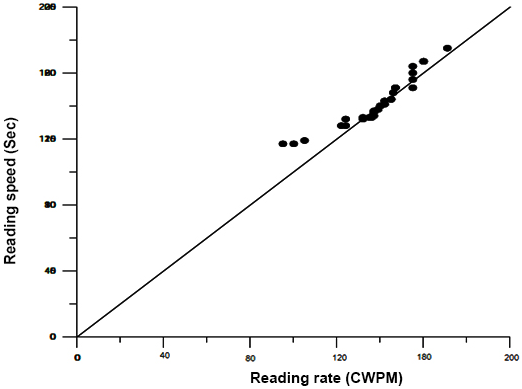
| Table 3: Pearson Correlation Coefficient and Chi-Square Test Showing the Association between Reading Rate and Colour Luminance N=60. |
| Luminance (400 lux) |
Variables |
Mean±SD |
Correlation |
Chi square test analysis |
| r |
df |
X2 |
p value |
| White colour
(CFL) |
Reading errors |
3.3±1.74 |
+0.778 |
2 |
53.2 |
<0.0001 |
| Orange colour
(Tungsten) |
Reading errors |
6.23±2.94 |
| *p<0.005 is considered as significant |
Figure 4: Spike Raster Plot Showing the Reading Speed (Sec) in White Colour Luminance (Flouroscent-400 lux) and Colour Temperature=3050 Kelvin.
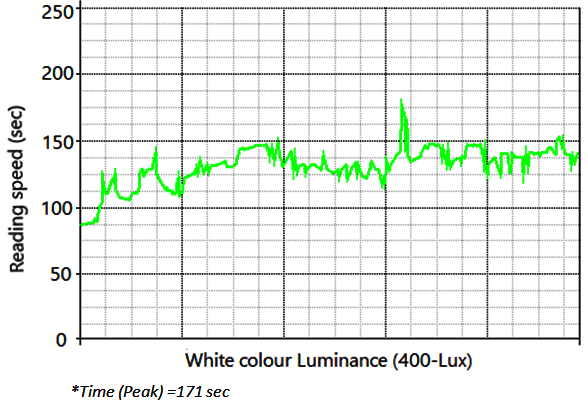
Figure 5: Spike Raster Plot Showing the Reading Speed (Sec) in Orange Colour Luminance (Tungsten-400 lux) and Colour temperature=3000 Kelvin
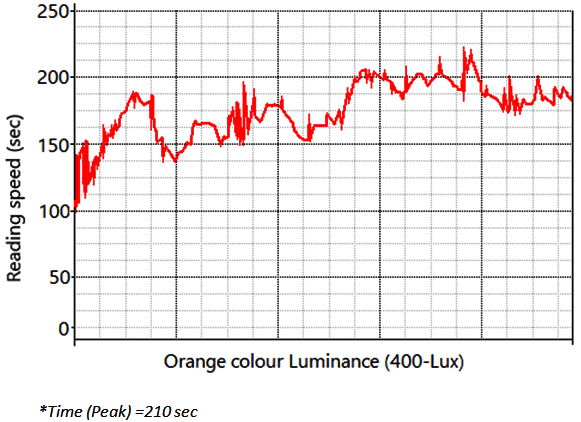
Figure 6: Box and Whisker Plot Showing the Reading Errors Association between White and Orange Colour Luminance (400 lux), N=60.
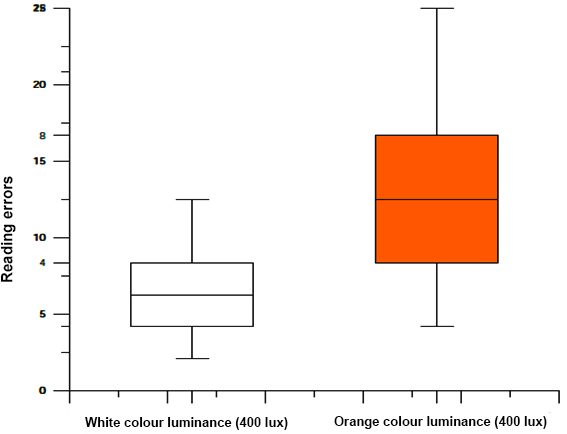
Figure 7: Bar Graph Showing the Symptoms Experienced by Participants after Experiment in Two Groups, N=60 (Sample Size).
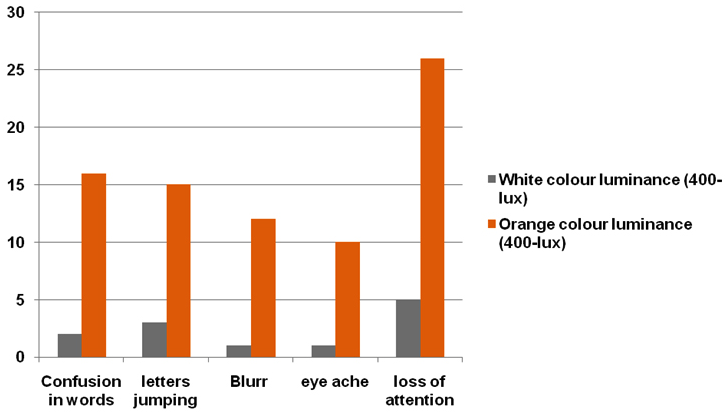
DISCUSSION
In the current study, an attempt has been made to explore the psychological pleasure of reading and visual cognition under two colour luminance sources (white and warm orangish). However, the results were consistent and supported by the observations of the existing studies. In the present study, it was found that colour luminance played a role in identifying the reading of the comprehension and visual cognition was slow under (warm orangish) lighting similar to the findings of Schlesewsky et al11. Studies have shown that luminance is the variable influencing the contrast during process of reading. However, visual cognition and psychological pleasure experienced by the participants was good under white colour luminance than warm orange colour luminance. Thus, it was also noted that white colour luminance increased the cognitive visual tasks similar to the observations of the study by Baron et al12. Supported with our findings, it was found that insufficient illumination and colour of luminance also influenced the behavior and cognitive tasks. Reading errors were found more in the participants who read under orange colour luminance than white colour luminance, similarly reading speed was good in white colour luminance but not under orange colour luminance. The equal readability score passage for both the English native speakers showed a difference in reading under two colour luminance’s. The illumination colour could be accountable for this discrepancy in the observation.
Moreover, these findings supported by Kim et al13 found that Korean words and visual features were affected due to logographic and syllables property. But in this study, visual cognition and reading text was observed to influence reading under colour luminance.
However, reading symptoms and visual comfort was good under white colour luminance followed by psychological pleasure for a printed material. Our findings also showed that printed material influenced the reading of comprehension and visual cognition under colour luminance concomitant with the findings of Botello et al.14 Existing studies showed that background colour on computer screens also influenced the text and the reading of the comprehension in relation to the printed material in which it showed minimal effects. Moreover in this paper, the focus was on the visual cognition, reading and psychological pleasure variables like eye movements and assessment of the blink rate for further understanding of psycholinguistics to undertake future research.
CONCLUSION
The present study showed that psychological pleasure under colour luminance played a role in influencing reading performance and visual cognition. Participants were psychologically more pleasant and visual cognition and reading was better under a white colour luminance source relative to orange colour luminance. It was also suggested that white colour luminance resulted in better satisfaction for near visual task reading. This study also explained that the reading speed was better in white colour luminance with a low reading error rate in comparison to warm orangish colour luminance.
ACKNOWLEDGEMENTS
The authors would like to thank Dr. Supriya Bhardwaj for inputs in this experiment and CNF faculty, University of Hyderabad for providing Matlab-2015A software and to all the participants for their patience in the experiment.
CONFLICTS OF INTEREST
The authors declare that they have no conflicts of interest.
Note: This Manuscript was extracted from Male Shiva Ram (11IMMO14) I. M.Sc (Optometry and Vision Science) dissertation title: Influence of illumination on reading.











